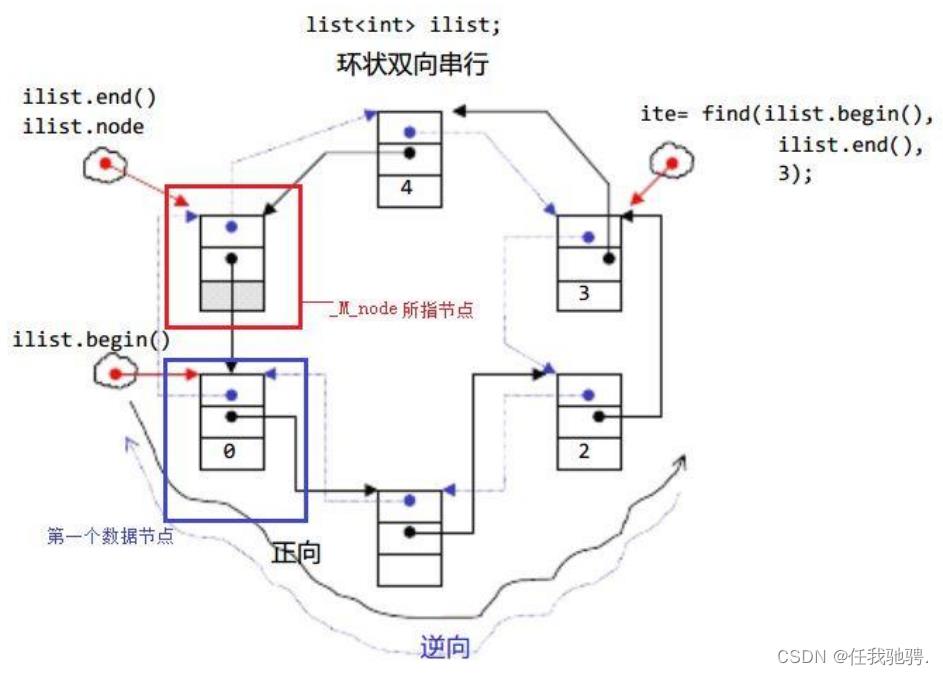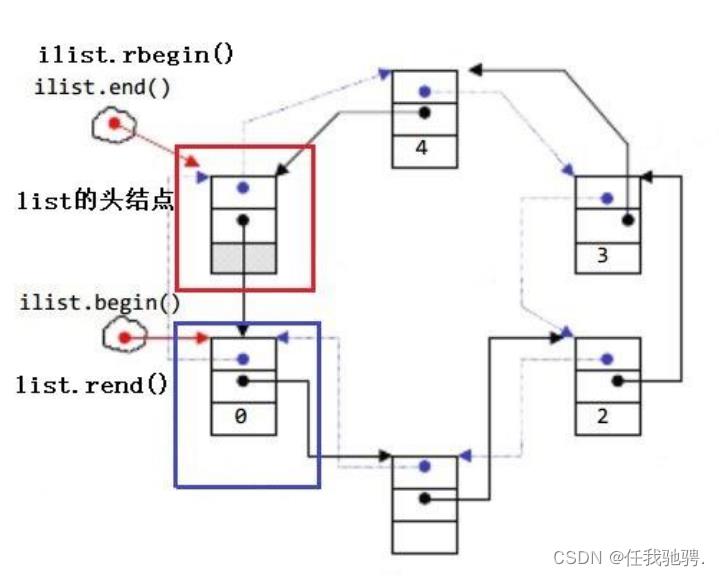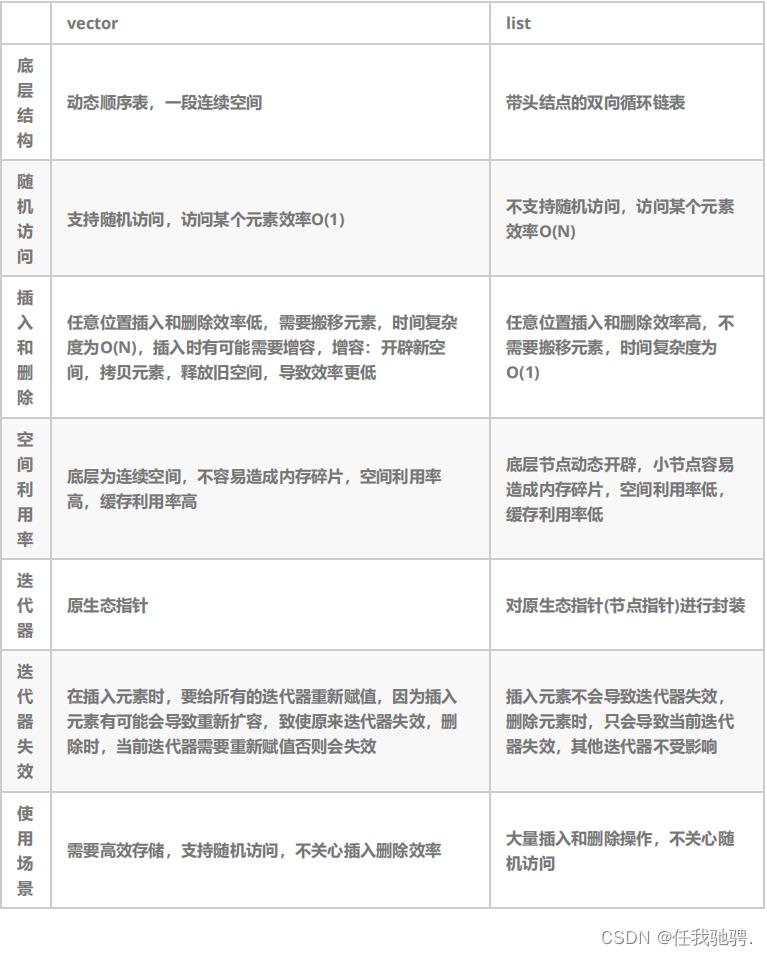C++ list
Posted 任我驰骋.
tags:
篇首语:本文由小常识网(cha138.com)小编为大家整理,主要介绍了C++ list相关的知识,希望对你有一定的参考价值。
list
一、list的介绍及使用
list的介绍
- list是可以在常数范围内在任意位置进行插入和删除的序列式容器,并且该容器可以前后双向迭代。
- list的底层是双向链表结构,双向链表中每个元素存储在互不相关的独立节点中,在节点中通过指针指向其前一个元素和后一个元素。
- list与forward_list非常相似:最主要的不同在forward_list是单链表,只能朝前迭代,已让其更简单高效。
- 与其他的序列式容器相比(array,vector,deque),list通常在任意位置进行插入、移除元素的执行效率更好。
- 与其他序列式容器相比,list和forward_list最大的缺陷是不支持任意位置的随机访问,比如:要访问list的第6个元素,必须从已知的位置(比如头部或者尾部)迭代到该位置,在这段位置上迭代需要线性的时间开销;list还需要一些额外的空间,以保存每个节点的相关联信息(对于存储类型较小元素的大list来说这可能是一个重要的因素)

list的使用
list中的接口比较多,此处类似,只需要掌握如何正确的使用,然后再去深入研究背后的原理,已达到可扩展的能力。以下为list中一些常见的重要接口。
list的构造

// constructing lists
#include <iostream>
#include <list>
int main ()
std::list<int> l1; // 构造空的l1
std::list<int> l2 (4,100); // l2中放4个值为100的元素
std::list<int> l3 (l2.begin(), l2.end()); // 用l2的[begin(), end())左闭右开的区间构造l3
std::list<int> l4 (l3); // 用l3拷贝构造l4
// 以数组为迭代器区间构造l5
int array[] = 16,2,77,29;
std::list<int> l5 (array, array + sizeof(array) / sizeof(int) );
// 用迭代器方式打印l5中的元素
for(std::list<int>::iterator it = l5.begin(); it != l5.end(); it++)
std::cout << *it << " ";
std::cout<<endl;
// C++11范围for的方式遍历
for(auto& e : l5)
std::cout<< e << " ";
std::cout<<endl;
return 0;
list iterator的使用
此处,可暂时将迭代器理解成一个指针,该指针指向list中的某个节点。


注意:
1. begin与end为正向迭代器,对迭代器执行++操作,迭代器向后移动
2. rbegin(end)与rend(begin)为反向迭代器,对迭代器执行++操作,迭代器向前移动
#include <iostream>
using namespace std;
#include <list>
void print_list(const list<int>& l)
// 注意这里调用的是list的 begin() const,返回list的const_iterator对象
for (list<int>::const_iterator it = l.begin(); it != l.end(); ++it)
cout << *it << " ";
// *it = 10; 编译不通过
cout << endl;
int main()
int array[] = 1, 2, 3, 4, 5, 6, 7, 8, 9, 0 ;
list<int> l(array, array + sizeof(array) / sizeof(array[0]));
// 使用正向迭代器正向list中的元素
for (list<int>::iterator it = l.begin(); it != l.end(); ++it)
cout << *it << " ";
cout << endl;
// 使用反向迭代器逆向打印list中的元素
for (list<int>::reverse_iterator it = l.rbegin(); it != l.rend(); ++it)
cout << *it << " ";
cout << endl;
return 0;
list capacity:

list element access:

list modifiers

#include <list>
void PrintList(list<int>& l)
for (auto& e : l)
cout << e << " ";
cout << endl;
//=====================================================================================
====
// push_back/pop_back/push_front/pop_front
void TestList1()
int array[] = 1, 2, 3 ;
list<int> L(array, array+sizeof(array)/sizeof(array[0]));
// 在list的尾部插入4,头部插入0
L.push_back(4);
L.push_front(0);
PrintList(L);
// 删除list尾部节点和头部节点
L.pop_back();
L.pop_front();
PrintList(L);
//=====================================================================================
====
// insert /erase
void TestList3()
int array1[] = 1, 2, 3 ;
list<int> L(array1, array1+sizeof(array1)/sizeof(array1[0]));
// 获取链表中第二个节点
auto pos = ++L.begin();
cout << *pos << endl;
// 在pos前插入值为4的元素
L.insert(pos, 4);
PrintList(L);
// 在pos前插入5个值为5的元素
L.insert(pos, 5, 5);
PrintList(L);
// 在pos前插入[v.begin(), v.end)区间中的元素
vector<int> v 7, 8, 9 ;
L.insert(pos, v.begin(), v.end());
PrintList(L);
// 删除pos位置上的元素
L.erase(pos);
PrintList(L);
// 删除list中[begin, end)区间中的元素,即删除list中的所有元素
L.erase(L.begin(), L.end());
PrintList(L);
// resize/swap/clear
void TestList4()
// 用数组来构造list
int array1[] = 1, 2, 3 ;
list<int> l1(array1, array1+sizeof(array1)/sizeof(array1[0]));
PrintList(l1);
// 交换l1和l2中的元素
l1.swap(l2);
PrintList(l1);
PrintList(l2);
// 将l2中的元素清空
l2.clear();
cout<<l2.size()<<endl;
list的迭代器失效
前面说过,此处大家可将迭代器暂时理解成类似于指针,迭代器失效即迭代器所指向的节点的无效,即该节点被删除了。因为list的底层结构为带头结点的双向循环链表,因此在list中进行插入时是不会导致list的迭代器失效的,只有在删除时才会失效,并且失效的只是指向被删除节点的迭代器,其他迭代器不会受到影响。
void TestListIterator1()
int array[] = 1, 2, 3, 4, 5, 6, 7, 8, 9, 0 ;
list<int> l(array, array+sizeof(array)/sizeof(array[0]));
auto it = l.begin();
while (it != l.end())
// erase()函数执行后,it所指向的节点已被删除,因此it无效,在下一次使用it时,必须先给
其赋值
l.erase(it);
++it;
// 改正
void TestListIterator()
int array[] = 1, 2, 3, 4, 5, 6, 7, 8, 9, 0 ;
list<int> l(array, array+sizeof(array)/sizeof(array[0]));
auto it = l.begin();
while (it != l.end())
l.erase(it++); // it = l.erase(it);
二、list与vector的对比
vector与list都是STL中非常重要的序列式容器,由于两个容器的底层结构不同,导致其特性以及应用场景不同,其主要不同如下:

以上是关于C++ list的主要内容,如果未能解决你的问题,请参考以下文章